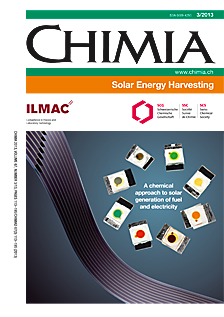An n-Si/n-Fe2O3 Heterojunction Tandem Photoanode for Solar Water Splitting
DOI:
https://doi.org/10.2533/chimia.2013.168Keywords:
Hematite, Heterojunction, Silicon, Tandem photoanode, Water splittingAbstract
Few metal oxide photoanodes are able to reduce protons to hydrogen because their conduction band minimum is located at too positive potentials. This can be remedied by biasing the photoanode with a photovoltaic cell placed behind the photoanode. The disadvantage of such a tandem device is the rather complicated structure. Here, we demonstrate a very simple monolithic heterojunction tandem photoanode based on n-Si and n-type ?-Fe2O3. Detailed characterization of this system in a basic planar configuration reveals that the silicon generates a photovoltage of ?0.3 V, and that the heterojunction functions as a D4 tandem device in which the absorption of two photons leads to one high-energy electron in the external circuit. No Fermi level pinning occurs at the Si/Fe2O3 interface, and the tandem photoanode is thermodynamically able to split water without the need for an external bias potential. This suggests that the n-Si/n-Fe2O3 heterojunction photoanode is a promising system for solar water splitting.Downloads
Published
2013-03-27
Issue
Section
Scientific Articles
License
Copyright (c) 2013 Swiss Chemical Society

This work is licensed under a Creative Commons Attribution-NonCommercial 4.0 International License.
How to Cite
[1]
R. van de Krol, Y. Liang, Chimia 2013, 67, 168, DOI: 10.2533/chimia.2013.168.







